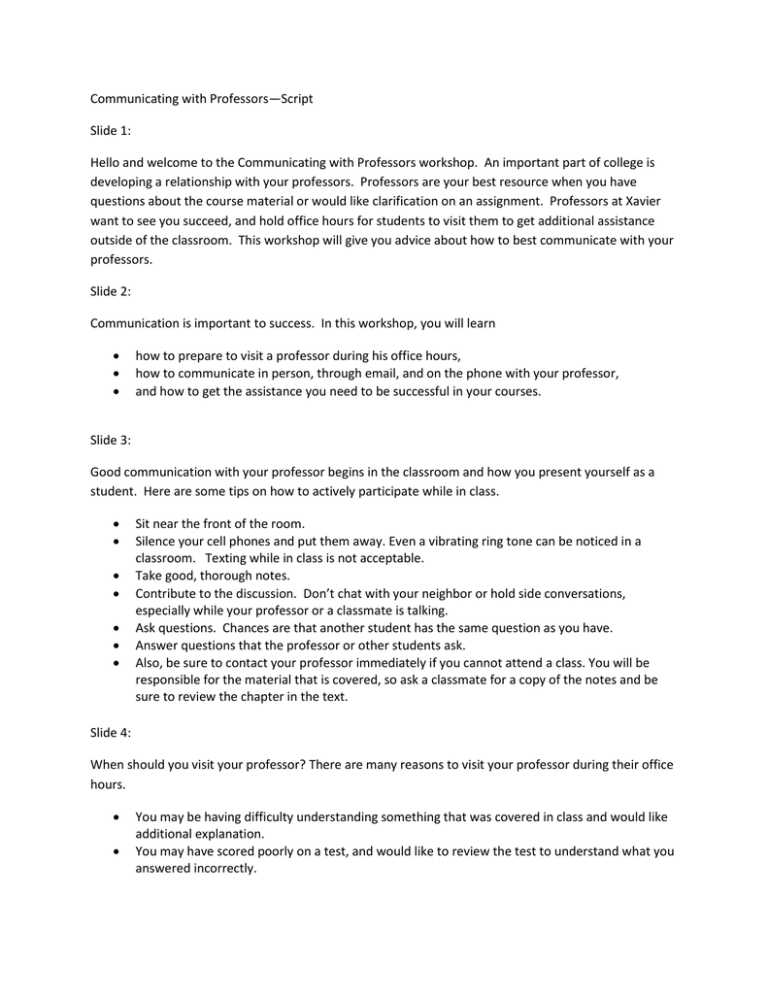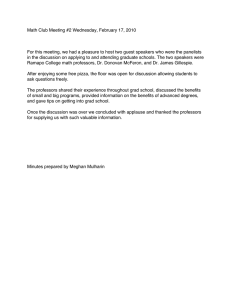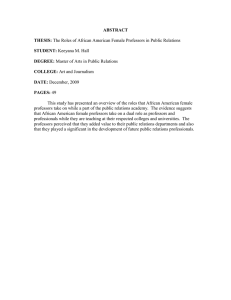Communicating with Professors—Script Slide 1:
advertisement

Communicating with Professors—Script Slide 1: Hello and welcome to the Communicating with Professors workshop. An important part of college is developing a relationship with your professors. Professors are your best resource when you have questions about the course material or would like clarification on an assignment. Professors at Xavier want to see you succeed, and hold office hours for students to visit them to get additional assistance outside of the classroom. This workshop will give you advice about how to best communicate with your professors. Slide 2: Communication is important to success. In this workshop, you will learn how to prepare to visit a professor during his office hours, how to communicate in person, through email, and on the phone with your professor, and how to get the assistance you need to be successful in your courses. Slide 3: Good communication with your professor begins in the classroom and how you present yourself as a student. Here are some tips on how to actively participate while in class. Sit near the front of the room. Silence your cell phones and put them away. Even a vibrating ring tone can be noticed in a classroom. Texting while in class is not acceptable. Take good, thorough notes. Contribute to the discussion. Don’t chat with your neighbor or hold side conversations, especially while your professor or a classmate is talking. Ask questions. Chances are that another student has the same question as you have. Answer questions that the professor or other students ask. Also, be sure to contact your professor immediately if you cannot attend a class. You will be responsible for the material that is covered, so ask a classmate for a copy of the notes and be sure to review the chapter in the text. Slide 4: When should you visit your professor? There are many reasons to visit your professor during their office hours. You may be having difficulty understanding something that was covered in class and would like additional explanation. You may have scored poorly on a test, and would like to review the test to understand what you answered incorrectly. You may be concerned about your current grade, have a question about an assignment, or would like to discuss your attendance or class participation. If any of these apply to you, then it’s time to visit your professor! Slide 5: Your professors provide valuable information on your course syllabus, including how to get in touch with them. Check your syllabus for your professor’s phone number, email address, office location, office hours, and whether the professor is available by appointment. Slide 6: It is a good idea to prepare for your meeting with your professor. Here are some things to do prior to your visit. Remember that your professor’s office hours are their preferred time to meet. It may be a good idea to mention to your professor that you will be coming by. If you are not available during any of your professor’s scheduled office hours, then you will want to make an appointment to meet with him or her. You can talk to your professor before or after class to schedule a time. You could also email or call them. Be sure to include your availability, so they can determine a time that works well for both of you. Try not to cancel your appointment. However, if you cannot attend, be sure to notify your professor as soon as possible. Prepare good, specific questions and gather materials such as your notes, textbook, previous tests, assignments, etc. If you want assistance with a paper, you should bring a draft to edit. If you are having trouble understanding something that you are reading, be ready to reference a specific part of the text. If you are having trouble working out problems, be sure to try the problems ahead of time so you know what you need assistance with. Slide 7: During your meeting, explain to your professor how you study—whether you are focusing on the material in the text, from the lecture, or both; whether you understand the assigned readings, are working the practice problems, etc. Ask your professor how he recommends to study and prepare for the course. Your professor may know of other students in the class who may be interested in studying together. He may also have other resources to aid you with your studies. Be sure to come prepared—bring a list of specific questions. You should run the session as much as possible. Slide 8: Don’t be afraid to ask questions. ANY question is better than no question at all, but a GOOD QUESTION will allow your professor to quickly identify exactly WHAT you don’t understand. For example, while it is fine to ask “How do you do #17?” A better question may be “Can you show me how to start #17?” This way the professor can get you started on the problem, but then you can try to finish the problem yourself. Or you can ask “This is how I tried to do #17. What went wrong?” This question focuses on your thought process. Right after you get help with a problem, it is a good idea to work a similar problem on your own. Slide 9: Now let’s consider communicating with your professor via email. Here are some tips on how to best present yourself in email correspondence. Be sure to include a greeting such as Dear Professor Smith. It may also be a good idea to briefly introduce yourself. Use correct grammar. Don’t write as if you are texting. Ask nicely. Do not demand. Remember that tone is lost over email. Do not be vague in your email. Be specific about why you are emailing your professor. If you are scheduling a meeting, be sure to include your availability—and as much as possible. Be sure to notify your professor as soon as possible if you have to cancel a meeting. If you want to reschedule, again include your availability. End your email with a closing and include your name. Slide 10: Here are some additional communication tips that may be helpful. When addressing your professor, use a title, such as Professor Smith or Dr. Smith. They will let you know if you should address them differently. Be respectful of closed doors. The professor may not be there, be with another student or be busy. You can wait patiently, leave a note, email the professor, or try again later. Before you choose your ring-back tone and outgoing message, think about how professional it is. Ask yourself, “Would you want a future employer to hear it?” Do not call and hang up repeatedly without leaving a message. Leave a message so the person can return your call as soon as they are available. Be sure to include your full name and phone number. It may be helpful if you spell your last name and speak slowly. Slide 11: Thank you for viewing the “Communicating with your Professor” workshop. We hope that you have learned how and when to utilize your professors’ office hours, how to communicate with your professor, and that you will apply this advice and visit your professor soon! If you would like additional information, please talk to one of your professors or your academic advisor for advice. We would like to support your success! Please take the short quiz that is posted on the website to complete the Communicating with Professors workshop.

